 |
|
 |
 |
 |
 |
Don Mueang International Airport
ท่าอากาศยานนานาชาติดอนเมือง |
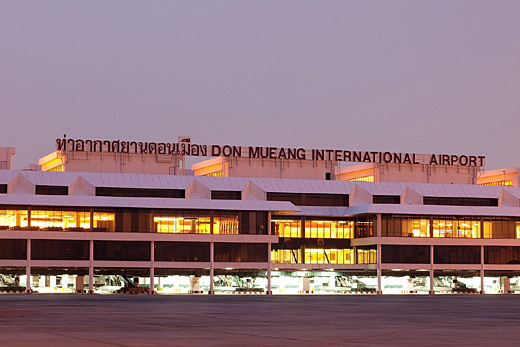 |
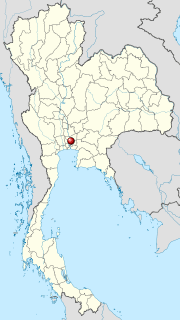
IATA: DMK – ICAO: VTBD |
| Summary |
| Airport type |
Public |
| Operator |
Airports of Thailand |
| Location |
Bangkok, Thailand |
| Hub for |
- One-Two-Go Airlines
- Nok Air
|
| Elevation AMSL |
9 ft / 3 m |
| Coordinates |
13°54′45″N 100°36′24″E / 13.9125°N 100.60667°E / 13.9125; 100.60667 |
| Runways |
| Direction |
Length |
Surface |
| ft |
m |
| 03L/21R |
12,139 |
3,700 |
Asphalt |
| 03R/21L |
11,482 |
3,500 |
Asphalt |
- For the military use of the facility see Don Muang Royal Thai Air Force Base
Don Mueang International Airport (IATA: DMK, ICAO: VTBD) (or also (Old) Bangkok International Airport) (Thai: ท่าอากาศยานดอนเมือง, formerly spelled Don Muang) is an airport in Bangkok, Thailand. It was officially opened as a Royal Thai Air Force base on March 27, 1914, although it had been in use earlier. Commercial flights started in 1924. Don Mueang Airport closed in 2006 following the opening of Bangkok's new Suvarnabhumi Airport, before opening again after the big renovation on March 24, 2007.
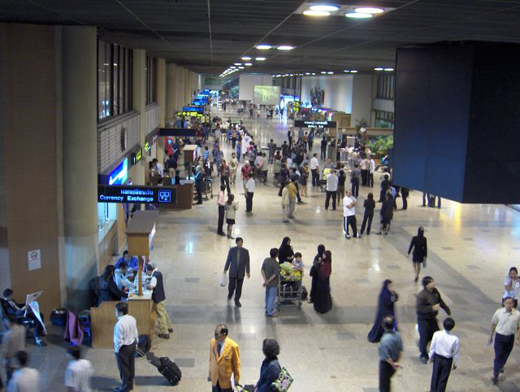
Don Mueang was an important hub of Asia and the hub of Thai Airways International prior to its closure. At its peak, it served most air traffic in the whole continent, with 80 airlines operating 160,000 flights and handling over 38,000,000 passengers and 700,000 tons of cargo in 2005. It was then the 18th busiest airport in the world and 2nd in Asia by passenger volume.
On September 28, 2006 the airport was replaced by Suvarnabhumi Airport. Don Mueang became a facility for charter flights, military aircraft and civil aviation. The airport was reopened for non-connecting domestic commercial flights on March 24, 2007. Two airlines are now using the airport: Nok Air and One-Two-GO Airlines. All Thai Airways domestic flights were transferred to Suvarnabhumi airport on March 28, 2009. (Bangkok Post, 20 june 2006: "All flights must use new airport from Sept 28").
Don Mueang is a joint-use facility with the Royal Thai Air Force's Don Muang Royal Thai Air Force Base, and is the home of the RTAF 1st Air Division, which consists primarily of non-combat aircraft. Vibhavadi Rangsit Road is the main route linking the airport with downtown Bangkok. The Uttaraphimuk Elevated Tollway, running above Vibhavadi Rangsit, offers a more rapid option for getting into the city and connects to Bangkok's inner city expressway network. There is also rail service connecting with Hua Lamphong station in the center of Bangkok. The train station is across the highway and is linked with the airport by a walkway bridge. An RTAF golf course is located between the two runways. The course has no separation from the runway, and golfers are held back by a red light whenever planes land.
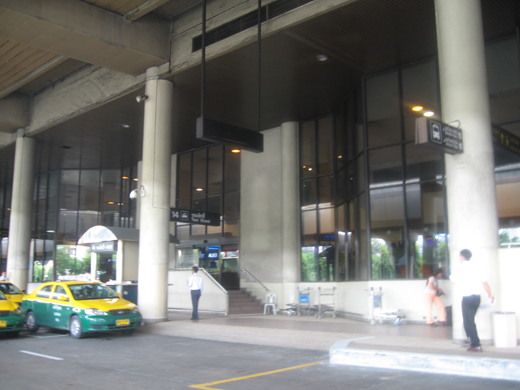 | |
Arrival Hall |
 | |
Shopping Plaza |
Don Mueang airfield was the second established in Thailand, after Sa Pathum, which is now Sa Pathum horse racing course. The first flights to Don Mueang were made on March 8, 1914 and involved the transfer of aircraft of the Royal Thai Air Force. Three years earlier, Thailand had sent three army officers to France to train as pilots. On completion of their training in 1911, the pilots were authorized to purchase four Breguets and four Nieuports, which formed the basis of the Royal Thai Air Force.
In 1933 the airfield was the scene of heavy fighting between royalists and government forces during the Boworadet Rebellion.
Commercial service to Don Mueang began in 1924. The first commercial flight was an arrival by KLM.
The airfield was used by the occupying Japanese during World War II, and was bombed and strafed by Allied aircraft on several occasions.
During the Vietnam War, Don Muang Royal Thai Air Force Base was a major command and logistics hub of the United States Air Force.
Before the opening of Suvarnabhumi, the airport used the IATA airport code BKK and the name was spelled Don Muang. After Suvarnabhumi opened for commercial flights, the spelling was changed and as Don Mueang it now uses the airport code DMK, though it still retains the ICAO airport code VTBD.
Gellery
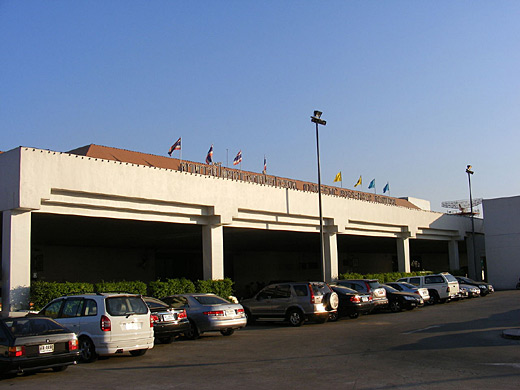
Don Mueang International Airport - domestic terminal
Click to enlarge
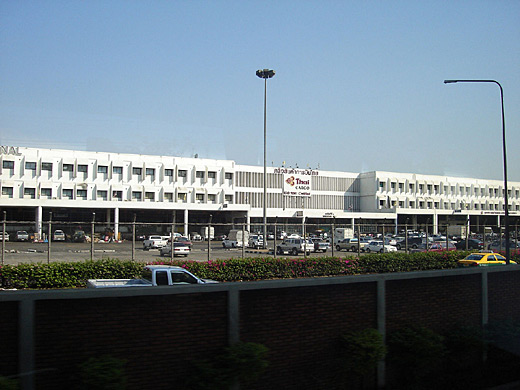
Don Mueang International Airport
Click to enlarge
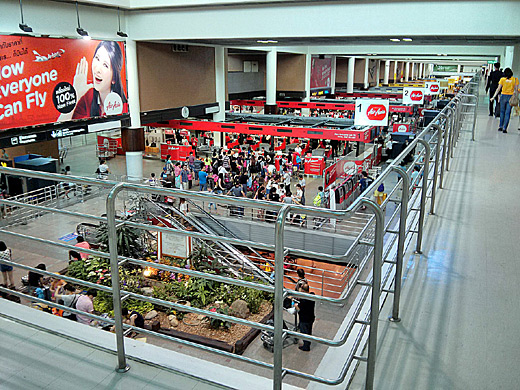
Don Mueang International Airport
Click to enlarge
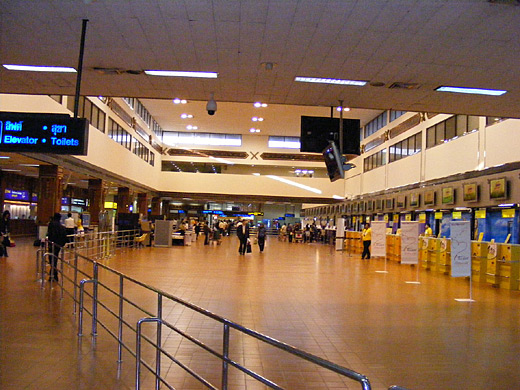
Don Mueang International Airport
Click to enlarge
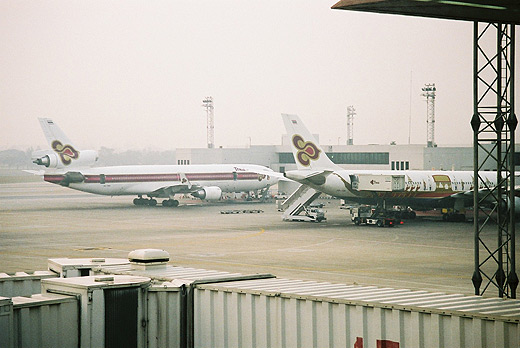
Don Mueang International Airport -
Click to enlarge
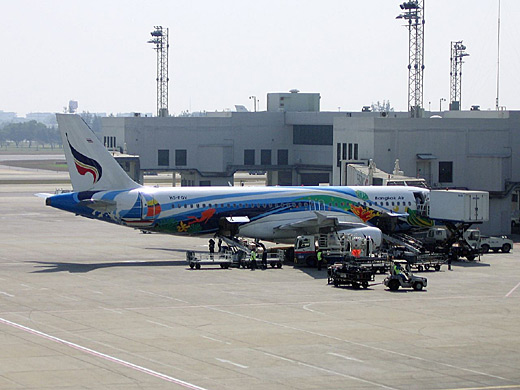
Don Mueang International Airport
Click to enlarge
Accidents and incidents
- 14 June 1972 – Japan Airlines Flight 471, which originated at Don Mueang, crashed outside of New Delhi's Palam International Airport, killing 82 of 87 occupants; 10 of 11 crew members and 72 of 76 passengers died, and 3 people on the ground died. 16 of the dead were Americans.
- 25 December 1976 – EgyptAir Flight 864, a Boeing 707-300 bound for Bangkok from Cairo, crashed into an industrial area near the airport during a landing attempt. All 53 aboard were killed.
- 27 April 1980 – a Thai Airways BAe 748 en route from Khon Kaen to Bangkok lost altitude during a thunderstorm and crashed about 8 miles (13 km) from Bangkok International Airport. All four crew members and 40 of the 49 passengers were killed.
- 1981: The Hijacking of Flight Garuda Indonesia GA 206 on 28 March 1981. This was the first serious Indonesian airline hijacking, since the first was a desperate Marine hijacker who was killed by the pilot himself. The hijackers, a group called Commando Jihad, hijacked the DC 9 "Woyla", enroute from Palembang to Medan, and ordered the pilot to fly the plane to Colombo, Sri Lanka. As the plane didn't have enough fuel to reach Colombo, it refueled in Penang, Malaysia and then flew to Don Mueang. The hijackers demanded the release of Commando Jihad members imprisoned in Indonesia, and US$1.5 million, as well as another plane to take the released prisoners to an unspecified destination. The then Kopasandha commandos (now Kopassus), lead by Lieutenant Colonel Sintong Panjaitan and directly supervised by Lieutenant General Benny Moerdani as the head of the Armed Forces Intelligence, who took part in this mission, trained only three days with totally unfamiliar weapons, brilliantly executed this fast-paced operation. One of the Kopasandha commandos was shot by the hijacker leader, who then shot himself. The airliner's pilot, Captain Herman Rante, was shot dead, probably by a stray bullet. The other hijackers were killed and the hostages rescued.
- 29 November 1987 – Korean Air Flight 858, flying from Baghdad International Airport in Baghdad, Iraq to Abu Dhabi International Airport in Abu Dhabi, United Arab Emirates to Don Mueang to Gimpo Airport near Seoul, South Korea, exploded over the Andaman Sea after a bomb planted by North Korean agents exploded. Everyone on board died.
- 26 May 1991 – Lauda Air Flight 004, which was headed to Wien-Schwechat International Airport in Vienna, suffered an in-flight deployment of the thrust reverser on the No. 1 engine after taking off from Don Mueang. There were no survivors from the 213 passengers and 10 crew.
- 21 January 1992 - Douglas VC-47D L2-41/15/210 of the Royal Thai Air Force was damaged beyond repair in a landing accident.
- If Project Bojinka had not been discovered after a fire in Manila, one or more aircraft owned by U.S. carriers flying to Bangkok would have blown up over the Pacific Ocean on January 21, 1995 as part of the project's first phase.
- 22 August 1999 – China Airlines Flight 642, which was landing in Tropical Storm Sam at Hong Kong International Airport in Hong Kong on a route from Don Mueang to Hong Kong, rolled upside down on the runway. The plane came to rest upside down. 3 of the passengers died.
- 23 September 1999 – Qantas Flight 1, in what was then the most serious incident in the airline's famously safe jet aircraft history, saw a Boeing 747-400 overshoot the runway causing significant damage, but no casualties.
- 3 March 2001 – Thai Airways International Flight 114, a Thai Airways International Boeing 737-400 (HS-TDC), bound for Chiang Mai from Bangkok, was destroyed by an explosion and fire that occurred about 35 minutes before the Former Prime Minister Thaksin Shinawatra and about 150 other passengers were to board. Five members of the cabin crew were aboard, and one was killed. Witnesses said they heard an explosion before flames erupted aboard the aircraft. NTSB investigators reported that the center fuel tank exploded followed by the right tank 18 minutes later. The cause for the explosion was unclear; however, no traces of explosive were found. The center fuel tank is located near air conditioning packs, which generate heat and were running nonstop prior to the explosion.
- 19 April 2005 – a Singapore Airlines Boeing 777-200ER stopped approximately 194 meters beyond a painted stop line at Bangkok International Airport, and its left wing-tip was clipped by a Thai Airways International Airbus A330-300 taxiing for take-off. There were no injuries.
- 16 September 2007 – One-Two-GO Airlines Flight 269, a McDonnell Douglas MD-82 (HS-OMG), on a short routine flight from Don-Muang airport, Bangkok to Phuket International Airport the aircraft overran the runway in wild weather comprising of battering shower storms. Of 123 people on board, 88 were said to have been killed.
Last flights before the move to Suvarnabhumi
 | |
Thai Airways International planes at Don Mueang |
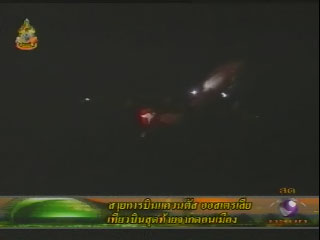 | |
Qantas flight QF302 departs as the last commercial departure from Don Mueang (from MCOT's live coverage) |
The night of September 27–28, 2006 was the official end of operations at Don Mueang airport. The last commercial flights were:
- Domestic departure: Thai Airways TG 124 to Chiang Mai at 22:15 (coincidentally, when Thai moved domestic operations back to Suvarnabhumi again on March 28, 2009, their last departure was also a 22:15 flight to Chiang Mai)
- International arrival: Kuwait Airways from Jakarta at 01:30
- Domestic arrival: TG 216 from Phuket at 23:00
- International departure: Although scheduled for Kuwait Airways KU 414 to Kuwait at 02:50 , Qantas flight QF302 to Sydney, originally scheduled for 18:00, was delayed for more than 9 hours before finally taking off at 03:12, about 10 minutes after the Kuwait flight. Qantas claimed that QF302 was an extra flight.
Nevertheless, Don Mueang continues to be used for charter flights as well as the domestic carriers despite the fact the higher landing fees of the new airport are now being applied to Don Mueang as well.
Reopening the airport
Although initially deserted by commercial carriers upon the opening of the Suvarnabhumi Airport, the higher costs of the new airport to operators as well as safety concerns over cracked runways at the new airport caused many to seek a return to Don Mueang. In particular, low-cost airlines have led demands for reopening of the airport. Airports of Thailand released a report at the end of 2006 which furthered this effort, proposing it as a way to avoid or delay second-stage expansion which had been planned for Suvarnbhumi.
On January 30, 2007, the Ministry of Transport recommended temporarily reopening Don Mueang while touch up work process on some taxiways at Suvarnabhumi proceeds. The recommendation was subject to approval by the government's executive Cabinet. On March 25, 2007, the airport officially reopened for some domestic flights.
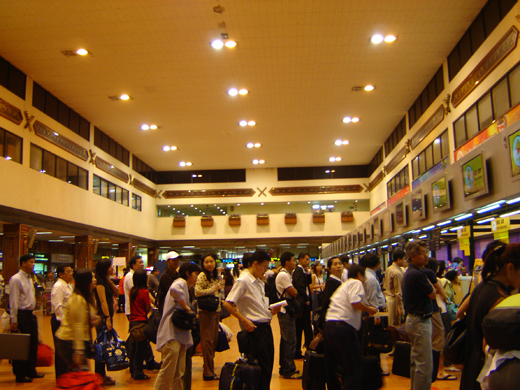 | |
Domestic Terminal |
Flights
Don Mueang International Airport has 3 terminals. Terminal 1 and Terminal 2, used as the international terminal before the opening of Suvarnabhumi Airport, are currently not used, while Terminal 3 is in active use as a domestic terminal.
Future plans for Terminal 1 and Terminal 2 are not yet officially published. It is speculated that Terminals 1 and 2 will later be utilised as a Low-cost carrier LCC facility.
Airlines and destinations
| Airlines |
Destinations |
| Nok Air |
Buri Ram, Chiang Mai, Hat Yai, Nakhon Si Thammarat, Nakhon Phanom, Phitsanulok, Phuket, Trang, Sakhon Nakhon, Surat Thani, Ubon Ratchathani, Udon Thani |
| One-Two-GO Airlines |
Chiang Mai, Chiang Rai, Hat Yai, Nakhon Si Thammarat, Narathiwat, Phuket, Trang |
The above content comes from Wikipedia and is published under free licenses – click here to read more.
| General Info
|
| Country |
Thailand
|
| ICAO ID |
VTBD
|
| Time |
UTC+7
|
| Latitude |
13.912583
13° 54' 45.30" N
|
| Longitude |
100.606750
100° 36' 24.30" E
|
| Elevation |
9 feet
3 meters
|
| Type |
Joint (Civil and Military)
|
| Magnetic Variation |
000° W (01/06)
|
| Beacon |
Yes
|
| Operating Agency |
MILITARY - CIVIL JOINT USE AIRPORT
|
| Alternate Name |
DON MUANG AB
|
| Operating Hours |
24 HOUR OPERATIONS
|
| International Clearance Status |
Airport of Entry
|
| Communications
|
| TWR |
118.1
236.6
|
| GND |
121.9
122.5
257.8
|
CLNC DEL
See PLANNING AP/3.
|
125.95
120.4
133.4
128.4
|
| ATIS |
126.4
344.6
|
| ARR |
125.5
|
| APP |
119.1
284.0
121.7
255.6
127.7
|
| Communications Remarks |
|
| GND |
(Btn 0100-1900Z - 121.9 Arr acft; 122.5 Dep acft)
|
| CLD |
Ctc 5 min prior to eng start.
|
| Runways
|
| ID |
Dimensions |
Surface |
PCN |
ILS
|
| 03R/21L |
11483 x 148 feet
3500 x 45 meters |
ASPHALT |
126FDWT |
YES
|
| 03L/21R |
12139 x 197 feet
3700 x 60 meters |
ASPHALT |
126FDWT |
YES
|
| Navaids
|
| Type |
ID |
Name |
Channel |
Freq |
Distance From Field |
Bearing From Navaid
|
| VOR-DME |
BKK |
BANGKOK |
124X |
117.7 |
1.3 NM |
029.0
|
| NDB |
BK |
BANGKOK |
- |
293 |
5.5 NM |
208.2
|
| Supplies/Equipment
|
| Fuel |
Jet A1+, Jet A1 with icing inhibitor.
Jet B, Wide cut turbine fuel, Without icing inhibitor.
JP-4, Wide cut turbine fuel MIL Spec T-5624
Jet A1, without icing nhibitor.
115/145 octane gasoline, leaded, MIL-L-5572F (PURPLE)
100/130 octane gasoline, leaded, MIL-L-5572F (GREEN)
100/130 MIL Spec, low lead, aviation gasoline (BLUE)
|
| Other Fluids |
LOX, Liquid oxygen servicing
|
| Remarks
|
| AOE |
Mil side Mon-Fri 0100-1000Z
|
| CAUTION |
Acft pushing back are on different freq and have rgt of way over arr acft. Hwy NW of thld Rwy 21R may be mistaken for rwy in poor vis.. Wide body acft will nottaxi along Twy T btn U and V while another wide body acft is ldg Rwy 03R-21L due to min wg tip clnc on E parl twy. House E of twy at mid fld will allow only 9'clnc for C5 acft when on taxi line. C5 taxi 16' W of twy cntrln to provide 25' wg tip clnc. Peak tfc congestion periods 0100-0430Z and 1500-1800Z dly. All intlacft should avoid ldg these hr. Bird haz.
|
| FLUID |
LOX
|
| FUEL |
A1 - (Bangkok Airport Fueling, fone C65-6-371-8363 (NC-100LL)
|
| LGT |
PAPI MEHT Rwy 03L-75', Rwy 21R-68', Rwy 03R-63', Rwy 21L-71'. Rwy 21L PAPI 3.15.
|
| MISC |
Sec Opr Agcy - RTAF.
|
| NS ABTMT |
See FLIP PLANNING AP/3.
|
| TFC PAT |
Jet tfc pat alt 1500', convl 1000', lgt acft 800', copter 500'.
|
| TRAN ALERT |
LOX svc is only avbl dur duty hr and must be req 24 hr in advance. Fleet svc notavbl for C141.
|
The content above was published at Airports-Worldwide.com in 2010.
We don't guarantee the information is fresh and accurate. The data may be wrong or outdated.
For more up-to-date information please refer to other sources.
|
 |



